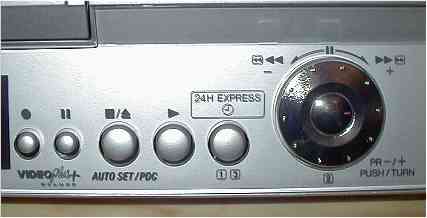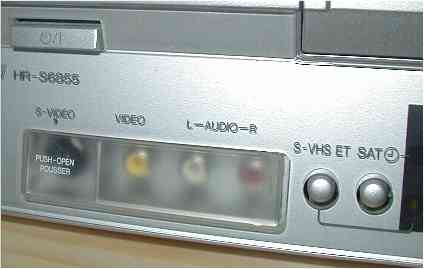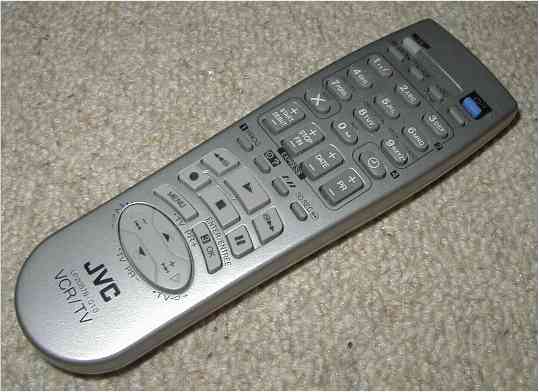|
|||||||||||||||
|
Introduction Do you remember when S-VHS was launched back in 1987? Within a year or so everyone would be won over by its quality, and the misery of VHS would be a thing of the past . . . . So here we are 15 years later, and S-VHS is still very much a niche that few people know about. If they did, then the market in plain VHS recorders costing more than £150 just wouldn't exist.
JVC has championed S-VHS and have broken from the pack by selling machines
for around the £200 mark for some time. Now there are several manufacturers
around this price point, including LG, Sharp, and a significant late
arrival, Panasonic. This generation of machines sports not only S-VHS
recording but also S-VHS ET. ET is, at least in this case, an earth bound
new comer - Expansion Technology. This awful buzzphrase allows S-VHS
recording on plain VHS tapes. Hard core users have known for years that
adding an ID hole to the underside of cassette cases could make machines
treat them as higher grade tape. S-VHS ET recognizes that some tape really
is good enough and will try its best after a short 'calibration' period when
it starts recording. Compared with top of the range models, it would be surprising if this deck was at all imposing. It is very much the same height as normal machines and is in fact slightly narrower than many, being only 400mm wide rather than the usual 430mm. It is light, although not empty feeling, and has no need for top side ventilation holes - a good sign and a welcome end to the ingress of dust. The front panel is quite minimalist, although it is embellished with a lightly frosted sheet of plastic and a slightly rickety, chromed plastic, multifunction jog/shuttle/channel dial. It has no reference detent, so changing speed during search can be hit and miss - a press changes mode and resets velocity! Chromed plastic never adds class, no exception here . . . .
Although this is an entry level model, front panel connections are included, albeit behind a very nasty flip out and lose cover. It's a clear cover clipped in to the plastic panel; it really is an annoyingly cheap blot which could have been done better quite easily. The front inputs aren't even hidden by this nasty flip out cover . . . .
The remote is light and a slightly darker shade of metallic paint than the machine, covered with buttons but with no jog-shuttle dial. Playback speed can be varied using the obligatory multi-function cursor pad. It is flat bottomed and has a peculiar cut-out allowing a wrist strap to be attached! I have enough trouble with the plague of remotes already - the idea of having all 7 attached to my wrist doesn't seem like the answer to my prayers.
Features Aside from S-VHS, and the welcome addition of its cost saving ET development (which works on standard tape only in SP, you still have to fork out for superior performance at lower speeds), there are plenty of other facilities to experiment with. It should go without saying that like all S-VHS recorders, it is a 'Hi Fi' Stereo recorder and has NICAM on board to make use of it. Of course, all its other inputs are stereo too, so satellite programs, camcorder footage, and anything else you throw at it is captured in fairly accurate 2 channel glory. Since it is at the very bottom of the range, you don't get any means of influencing this process - no dials, no level controls and no meters - you are at the mercy of its AGC (Automatic Gain Control), and as usual, the result seems to be slightly less vigorous than the original. Although bargain basement, there is one area where its richness of features is quite daunting, i.e., recording. In fact, satellite recording is threatened to be its forte. As well as Videoplus, one touch, direct TV, express timed and manual recording from any source, it has two extra ways to interact with your set-top box. The first is an infra-red pod which it can use to control the box, turning it on and choosing a channel before rolling. This requires placing the pod somewhere safe and programming the recorder to speak STB as well as knowing all its channel numbers by heart. The second attracted me more; the VTR can be set to run if the Digibox fires up. When programmed from the EPG, the box should turn on and change channel as requested, and the video just needs to do as it's told. I was sold, only one box would need to be battled with! And only the standard SCART is needed - what could be easier?
Well, as it turned out, catching the next flying porker to Paris would be
more straightforward. The JVC behaved faultlessly, recording being triggered
whenever the box was turned on, but the box would not activate itself.
Disappointing, I will be keeping an eye on this angle to see if later Sky
software upgrades or other makes of STB will play ball. Every effort has been made to reduce the brain power required to get this box to work. Turn on the power, and it'll all but completely set itself up. Stations are correctly identified and stacked in order. I have an extra set from a marginal transmitter but it was easy to delete these. It even sets its own clock. As hinted above, programming is very straightforward, the on screen menu text is enormous, and there are even dedicated buttons for start, stop, date, and station. If you use Videoplus, you are spared having to use those. The bulky, but clear, menus extend to various configuration parameters. These are simplistic, and this is fine for the obvious stuff, but some of the options, which are given only fleeting attention in the manual, are a little more obscure. For example, video stabilization sounds like the kind of feature which would be useful 24/7, but is hidden in the second page of options for the playback of rank rental tapes etc - no one will ever use it tucked away down there. Once the automatic satellite record option is set, there are a number of knock-on effects which require thorough reading to uncover. Likewise, although the option to change the deck's input and output formats from the menus is neat, the fact that one setting can change or lock the others is another wrinkle which sends you back to the book.
To JVC's credit, all the information is in there, but some effort in making
the menus and configuration intuitive would have paid dividends. Merely
making the text massive is not quite enough. Once configured, the machine is
actually very pleasant to use, and though clunky, the onscreen info makes
sure you know what's going on and behaves just as I'd hope. The video performance is very much as you would expect. VHS can only be pushed so far, and now that we live with DVD, its obvious flaws become more irksome. S-VHS SP performance is on a par with my older, much more expensive, decks. Of more interest is how well it maintains adequate performance when relegated to timeshifting rather than prime movie reproduction. LP is typical and benefits greatly from the extra detail it can store on real S-VHS tape. S-VHS ET does not work at lower speeds but is within a whisker of S-VHS at SP. Standard VHS playback is good, and LP is still what tends to get used in my house for bulk storage of Friday nights' schedule congestion. I wouldn't pretend it's pretty, but it holds up as well as any. EP is a dog of another shade. Americans have had this option for many years, but here we have managed without. SP VHS tape moves at only 23.4mm/s - that's half the speed of audio cassette! LP mode halves that throughput, with predictable results, and EP is only 1/3 of normal speed. It could be of use during a holiday, but the murky output reminds me of the terminal phases of a VTR's life at normal speeds. Again, to be fair, it's quite typical of the breed. If you really need 12 hours of woolly pictures on one 4 hour tape, it may be OK for you. As another feature to choose from - I would choose to leave it alone.
NTSC playback is a stock feature these days (even on these PAL machines),
but is worth comment here as the rendition of some underwatched tapes was
exemplary. My expectations were low, but I was very impressed with the
stable color and clean presentation of both domestic and pre-recorded tapes.
The so called 'Hi Fi' stereo associated with VHS for so long now is so
clever and so ubiquitous, that to snipe so late in the day is pointless. The
sound through this deck is a little dead, but rather than point a finger at
a serious loss of response, I would accuse the AGC (Automatic Gain Control).
These always err on the side of caution and whilst in A-B comparison, it
stifles the deck's initial presentation given a 1-2 dB boost, the audio
performance is restored to pleasing. VHS stereo is not a medium for subtlety
but an excellent daily recording workhouse, and so it is here. The JVC doesn't seem short of ins and outs, but given the amount of hardware people have piled in their living rooms these days, this machine falls just a little short. There are 2 SCART sockets; the first fully bi-directional and the second which can be configured for set top boxes or other sources. The most likely method of attachment assumes that the chain which this forms with your STB will use both the SCARTs. This is fine for basic viewing, but all that is left on the back for feeding to your surround amp is a pair of audio outputs. The front inputs are welcome and work well, but I would have preferred to see them and a matching set of outputs on the back panel for AV center connection.
I guess it's expecting a lot from a budget model to cater for home cinema,
but with more and more people reluctant to lay out serious cash on analog
recording, these would have been a cause for celebration. I may have to use
the monitor outputs from my TV to manage this shortage.
Ten years ago, you would have had to spend 3 or 4 times as much to get the
kind of performance this deck deals out for less than £200 (about $300 US).
The raft of set-up and timer automation would have been unthought of all
that time ago. Since then, JVC has ploughed a lonely furrow in bringing
S-VHS to the masses and deserve a lot of credit for persisting. Whilst
digital recorders are in their infancy, there is still a place for a solid
piece of home kit like this, and I'd recommend it ahead of spending serious
cash of any on the latest 'bit stores' until they can match the low cost and
versatility of tape. So, save your money by buying one of these now, and
have the last laugh when you can afford the next generation of DVD recorder
and enough discs to copy your tape library. Could be a long wait! - Rob Spray -
|
|||||||||||||||







